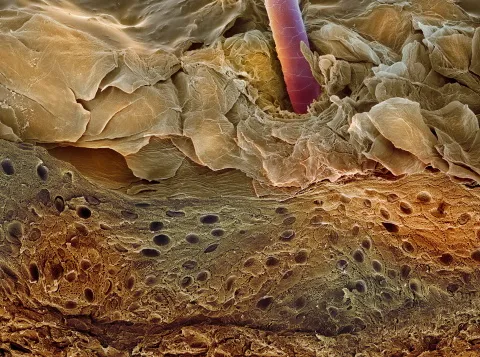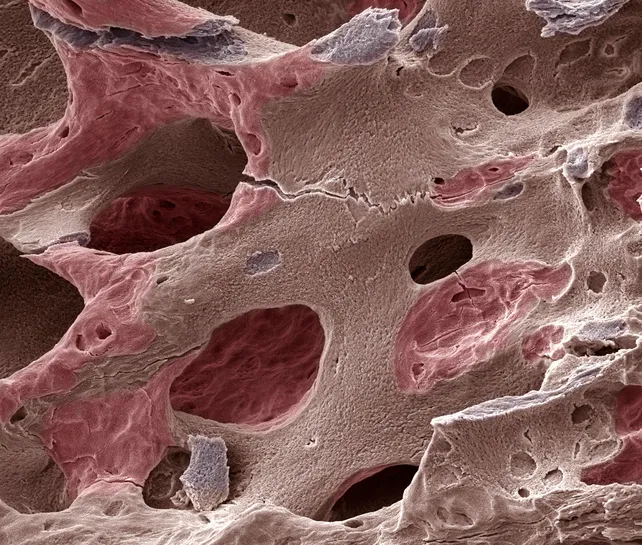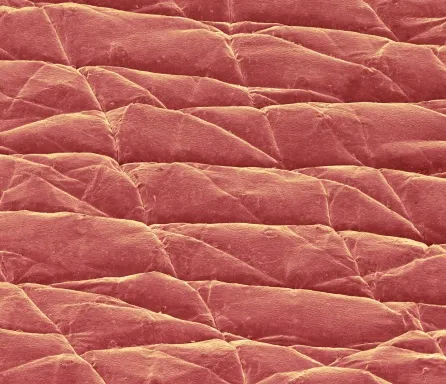Everything changes visually as it ages. Buildings start to crumble, cars become rusted, and fabrics get worn. Human features are certainly not immune to the passage of time, which brings with it grey hair, wrinkles and shrinking height.
You may have reluctantly accepted your fading hair colour and changing skin, or you may have clung to your younger appearance with treatments and dyes; but have you ever considered why these changes happen?
Going grey
Hair follicles harbour pigment cells known as melanocytes whichgenerate two coloured pigments: eumelanin (dark brown / black) and pheomelanin (red / yellow). These pigments are absorbed by keratinocytes. Keratinocytes make keratin, a strong substance that forms the physical structure of hair. The pigments are then incorporated into the juvenile hair fibres with the ratio of eumelanin to pheomelanin dictating the precise colour of each strand of hair.

Over time keratinocytes gradually die off, trapping melanin pigments within them. The melanocytes simultaneously perish so less pigment is transferred to the keratinocytes in the first place, resulting in lighter coloured locks.
Throughout life, stem cells - the precursors to melanocytes and keratinocytes - are used up, meaning replica cells to replace the expired cells are no longer produced. The keratinocytes and melanocytes continue to disappear until every hair lacks pigment and the individual has a full head of grey or white hair.
Reaching new heights
You're not imagining it:people do shrinkas they enter their senior years. This is due to gradual changes to the spine throughout an individual's life. The spine is comprised of vertebrae (individual back bones) with intervertebral disks slotted in between. The intervertebral disks have a porous structure allowing them to act as shock absorbers, thus reducing the impact on the bones. Inevitably, all of this pressure inflicted on the intervertebral disks damages them and makes them thinner. The cumulative loss in height of each intervertebral disk is enough to visibly reduce the individual's overall height.

As well as reduced total height, a person's posture can give the illusion that they are shorter. Older people tend to look even shorter because they become more hunched over, a phenomenon termed kyphosis. One cause of this is sarcopenia, the progressive loss of skeletal muscle mass and function. Osteoporosis, characterised by brittle bones and excessive loss of minerals from bones, is also a key contributor of kyphosis. When the vertebrae are more brittle, they are more susceptible to crush fractures and get squashed down. However, exposure to sunlight enables the body's production of vitamin D - crucial for bone strength - so what you really need to do to avoid shrinking is go on a sunny holiday!
A wrinkle in time
Countless beauty products boast an 'anti-aging' component to smooth the grooves life presses into our faces. The body's largest organ, skin is exposed to everything we encounter from our surroundings leaving it liable towear and tear.

Sunlight, for example, although vital for the natural production of vitamin D, is packed with ultra-violet (UV) rays. UV light penetrates the skin,degrading the collagen and elastinwhich form the skin's connective tissue and give it its elastic quality. As these molecules are broken down, the skin loses its elasticity. This means that skin cannot bounce back when moved by things like facial expressions and so forms wrinkles. UV light is not the sole culprit, smoking can also heighten the appearance of wrinkles by restricting blood flow to the skin. Similarly, dehydration can lead to wrinkles as well as some medication.
You can avoid the intensity of these physical changes by adopting a healthy lifestyle free from cigarettes and sunbeds, but ultimately embracing these changes will improve your confidence. Style your grey hair, show off those smile lines and remember the best things come in small packages!
